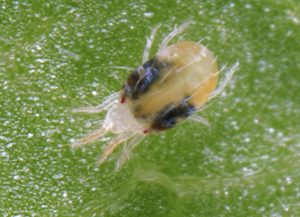For this article, we are going to talk about the pests that affect our cannabis plants in the hottest months of the year. We will also see how to avoid its appearance or, at least, delay it as much as possible. The pests that we will talk about this time are: The Red Spider, The Mites and the so-called Micro-mites. Do not miss this post if you want to learn to fight against these pests in a biological way and also how to fight them with the use of phytosanitary (chemicals), taking into account, above all, the safety deadlines to time to apply each of these products. Finally, we can see several tips for the use of these types of products.
Red Spider (Tetranychus urticae)
The Red Spider is the plague most feared by the indoor growers in the hottest months of the year. It is a tiny insect of the mite family , in which we can find countless names for different types of mite. The red spider is 1mm in size and for this reason it will be easier to locate them using a pocket microscope. This pest feeds on plants and we usually find it in the lower part of the leaves , at the beginning of its appearance, producing small bites on the underside of the leaves. With the passage of time, if we have not finished with it yet, we will be able to see how it weaves cobwebs on the outside of the plants, thus avoiding their perfect transpiration and causing irreparable damage such as: reducing photosynthetic efficiency , the perspiration of the same plant and reduce natural growth. The best way to avoid the appearance of the Red Spider will be by keeping the growing area clean and disinfected every time we start a new crop, with this we will prevent the spiders' eggs from remaining dormant and hatching reappearing in the future. It is very important to remember that this pest lays its eggs in the ground, where they also overwinter, therefore the soil of an infected plant should never be reused.

How to eliminate spider mites from marijuana plants?
- To combat this plague we can resort to biological remedies that we will find in our Grow Shop or we can also use predators (Phytoseiulus persimilis, Amblyseius californicus, stethorus) to control or fight against the red spider.
- Among the specific phytosanitary products to fight against Red Spider we find Abemectin and Milbectin, which are two chemical products that we should only use in the growth phase or in the first flowering week , we should never use these products when the flowers are maturing, as we run the risk that traces of these products may remain on them.
Remember that each pest has a growth time, therefore, we should repeat the fumigation several times, to avoid its reappearance.
Mites and Micro-mites
When we talk about Mites and Micro-mites , we are talking about arachnids that measure 1 mm in in the case of Mites and 0.2mm in the case of Micro Mites. These produce bites in the soft parts of our plants, weakening them to the point that it can slow down their vital rhythm . Due to the rapid growth rate of this pest , we must act quickly as in the previous case, or else we cannot expect to finish the flowering phase as we should.
How can we eliminate mites and micro-mites from marijuana plants?
- To fight against the mite in a biological way we could use a mixture of potassium soap and horticultural oil. We will spray this mixture throughout the plant, emphasizing the lower part of the leaves, where we can find most of these insects housed.
- To fight against these with phytosanitary products , we will continue using Abemectin and Milbectin, in the event that the plague persists, we can alternate the use of these two products. As in the previous case, cleaning the growing area and the tools we use will be of greater importance in the event of suffering from this pest, since it could appear on other occasions causing the same damage to our crop.
Advice for the use of biological insecticides
- Even being biological products, the use of gloves and a mask is still recommended.
- Making preparations with chlorine-free water can be an advantage, since we will be sure that we are not interfering with the effectiveness of that product.
- As with chemical insecticide preparations, we will adjust the preparation to the use we need at all times. That will make us take advantage of the products 100%.
Advice for the use of phytosanitary products
- We must use gloves and a suitable mask for the product we are using. Never prepare the mixture without wearing gloves as it could be dangerous. The use of a mask is recommended when spraying our cannabis plants.
- It is better to prepare the product mixture in little quantity , since if we prepare too much, we will have to discard it, causing damage to the ecosystem and making the use of the product more expensive.
- I never apply phytosanitary products when the plants are in the flowering phase, since that period is not specified by any manufacturer. In the case of using these products in the flowering phase, we must take as a reference the longest safety period recommended by the manufacturer of the product.
Until here one more week, I appreciate your reading to all.
Jhonny_Pot
Photos: «Tetranychus-urticae» by J. Holopainen - From my camera. Available under the GFDL license via Wikimedia Commons -
